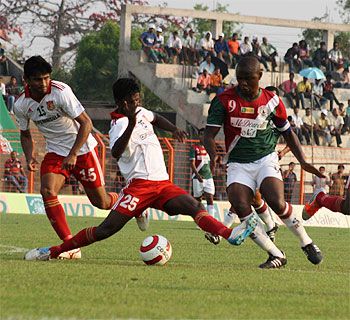The two giants of Indian football, Mohun Bagan and East Bengal, are facing turbulent times. On the pitch, East Bengal finished a respectable third in the 2012-13 I-League season, while Mohun Bagan finished a disappointing tenth.
Off the pitch, the clubs are up against financial problems. Both Mohun Bagan and East Bengal were being sponsored by tycoon Vijay Mallya’s UB Group for the last 15 years. With Mallya’s business interests taking a severe hit in the last 18 months, the two clubs are set to lose the UB Group’s support. While the UB Group hasn’t spelt out the actual plans for the football clubs, a 50 per cent cut in sponsorship money is expected. The recent investment fund scam in West Bengal hasn’t helped either, as the Saradha Group, implicated in the scam, was one of the principal sponsors of East Bengal.
 Indian football clubs, over the years, have struggled to monetise their popular appeal. Clubs like JCT Phagwara and Mahindra United have shut shop as poor returns on investment disappointed their company owners. Generally, revenue sources for Indian clubs come from sponsorships, tickets sales, player trading and merchandise sales.
Indian football clubs, over the years, have struggled to monetise their popular appeal. Clubs like JCT Phagwara and Mahindra United have shut shop as poor returns on investment disappointed their company owners. Generally, revenue sources for Indian clubs come from sponsorships, tickets sales, player trading and merchandise sales.
“These clubs’ revenue models are highly impractical,” says a former finance secretary of an I-league club. Unlike some other sports, the All India Football Federation, (AIFF), does not share broadcast revenue with I-League teams.
In 2011-12, the average attendance at an I-League match was less than 4,000. Although Mohun Bagan and East Bengal enjoy massive support in Kolkata, they’re hardly able to draw spectators. The match between the two rivals, however, is a big draw with over 40,000 people coming to the stadium.
The prize money for winning the I-League is about Rs 70 lakh. As the third ranked team, East Bengal won about Rs 35 lakh. Hurting from the chit-fund scams -- East Bengal had RoseValley and Saradha as sponsors -- clubs are now mooting the idea of a salary cap on players.
There were reports that Mohun Bagan had not paid their players their wages, but the club has denied this. The salary cap that has been proposed by East Bengal will have foreign players being paid a maximum salary of Rs 70 lakh, while domestic players would earn up to Rs 40 lakh. “Indian football has highly overpaid players,” says Debabrata Sarkar, a club official with East Bengal.
East Bengal plans to reduce the overall annual spend by Rs 10 crore -- much of it will come from salary cuts.
It’s always been difficult running a football club in India -- not even a simple I-League club makes a profit -- and tough times are ahead for clubs, especially the Kolkata clubs.
MOHUN BAGAN (2012-13)
Sponsorships: Approximately, a total of Rs 18 crore (Rs 15 crore from UB Group, Rs 1.5 crore from Saradha Group. Also from Adidas, Amra Remedies)
Ticket Sales: Negligible (Ticket price is Rs 50-200; average attendance is 5,000 per match)
Merchandise sales: Nil
Earnings from AIFF: Rs 35,000 for winning every game; Mohun Bagan won 11 games in 2012-13
Player salaries: About Rs 15 crore.
Top earner: Odafe Onyeka Okolie(Rs 2 crore p.a); Top Indian earner: Syed Rahim Nabi (Rs 1 crore)
EAST BENGAL (2012-13)
Sponsorships: Approximately Rs 20 crore (Rs 15 crore from UB Group, Rs 3.5 crore from Saradha Group. Also from RoseValley, Peerless, Nivia, Bluechip Projects)
Ticket Sales: Negligible (Ticket price is Rs 50-200; average attendance 5,000 per match)
Merchandise: Nil
Revenue from AIFF: Rs 35,000 for winning every game; East Bengal won 13 games in 2012-13. Got Rs 35 lakh for finishing third in I-League.
Player salaries: About Rs 13 crore.
Top earner: Uga Okpara (Rs 1. 5 crore); Top Indian earner: Mehtab Hossain (Rs 1 crore)








 © 2024 Rediff.com -
© 2024 Rediff.com -